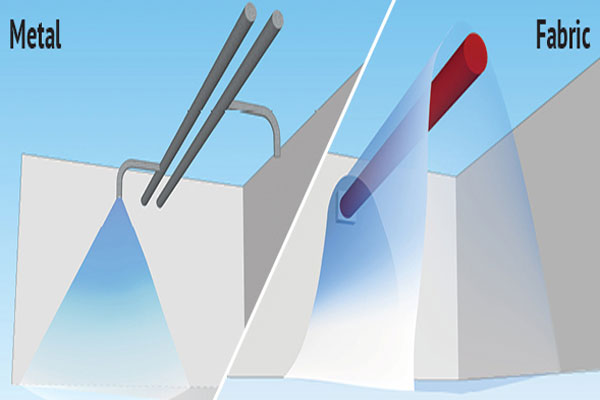In the 45 years since the first introduction of fabric-based air dispersion technology the concept has been developed and refined, but the primary differences between fabric and metal-based HVAC/R solutions are still founded on comfort, hygiene, efficiency and savings.
Conventional metal ducting uses spot diffusion, which creates stagnant air zones, unpleasant drafts and inconvenient noise pollution. From a comfort perspective this is the primary difference between metal solutions and FabricAir dispersion technology.
From a hygienic perspective, the condensation-free nature of fabric ducts diminishes the risk of microbial growth inside or on the ducting. Specific fabrics even have Cleanroom 3 certification. The fabrics are created in woven polyester fibers, which ensures that the ducts can be washed, even sterilized in an autoclave, without causing negative impact on their performance.
The initial advantage of fabric air dispersion technology was twofold: Eliminating drafts created a more healthy work environment, thus lowering the number of absences; and creating better airflow patterns resulted in a more even air distribution and lower temperature gradients in the meat processing plants where the technology was first applied. The latter has been an area of thorough research, which had led to a wide array of flow models that can be combined to optimize induction in any given project. This is part of what makes the technology more efficient than conventional metal solutions.
Surface flow models enable high air changes at low velocity, which is good for low ceiling applications and comfort. Directional flow models enable precise longer throws to create better induction in e.g. industrial production or high storage applications. May applications require unique combinations of airflow patterns to create the ideal air dispersion solution and using fabrics this is a straightforward creation process.
Through the use of proprietary 3D software and CFD modelling, air engineering experts design a solution specifically for a given project optimizing the airflow patterns based on the relevant parameters of the application and project specifics. Once the drawings are approved by the customers, the duct solution is tailored and shipped, arriving on site typically in less than 14 days, ready to install. This is another significant difference and an important efficiency aspect; the quickest lead times on the market.
Ease of installation is a hallmark of the technology. Instead of juggling huge, heavy steel duct pieces, the installer simply screws the rail onto the ceiling and slides the fabric ducts in place. No need for on-site attenuation, no grills or diffusors, no insulation or painting and no need for balancing. Installing a fabric-based solution is four to five times quicker than installing a metal-based solution; thus, depending on local labor costs the savings potential is significant – up to 70%.
With textile-based air dispersion technology, the air is distributed evenly across the room at low velocity, thus avoiding drafts, dead zones and minimizing noise (<30NC) for higher comfort. With permeable fabrics, no condensation is formed on or inside the ducts, even if the inlet temperature is below the dew point. This prevents bacterial growth and mold for a more hygienic indoor environment. The bespoke solutions ensure better dispersion patterns and higher efficiency with lower pressure drops. Contrary to metal ducting, fabric ducts only require simple tools, such as a screwdriver, to install, which entails significant cost savings. Those are the four primary technological difference between fabric and metal air dispersion solutions.
www.fabricair.com
Time and date
CONSTRUCTION DIRECTORY
Construction News
05/09/2018
Differences Between Metal And Fabric Air Dispersion Technology

Latest Construction News
25/11/2024
Estilo Interiors has been selected to help Bruntwood SciTech as they invest a further £2.4 million into Birmingham as part of a plan to transform its Mclaren innovation hub. The project, located less than five minutes' walk from the future HS2 Curzon Street Station, will involve the building ...
25/11/2024
Cambridge Investment Partnership (CIP) has reached a significant milestone at Aylesborough Close in Arbury, with the completion of a topping-out ceremony. CIP board members, ward councillors, One Public Estate, Homes England and the CIP team gathered to lay the final brick at the highest point of ...
25/11/2024
Lovell has appointed Nicola Colley as head of land in the West Midlands, boosting the business' expertise in land opportunities. Having previously worked at Lovell for 12 years, Nicola has returned to a brand-new role at the national housebuilder, bringing with her experience from Taylor Wimpey ...
25/11/2024
Stepnell has commenced enabling works for a significant £9 million refurbishment of the Grade II listed Town Hall in Hugh Town, located on St Mary's in the Isles of Scilly. Spearheaded by the Council of the Isles of Scilly in partnership with Scilly Arts & Heritage, the project marks a pivotal ...
25/11/2024
Morgan Sindall Construction has successfully completed the restoration of West Bromwich Town Hall and Library, restoring the significant building to its former glory for the community to enjoy. Prior to the project's handover, Morgan Sindall gave a presentation to the SMBC Members and Town ...
25/11/2024
Persimmon Homes Severn Valley has donated 10,000 bricks to AccXel, the Construction Skills Accelerator Centre in Cinderford. The contribution will enable students at the Gloucestershire-based facility to gain hands-on experience and develop essential skills for the construction industry. The ...
25/11/2024
Nearly a year after work began, significant progress is being made at Huddersfield station as part of the Transpennine Route Upgrade (TRU). This transformative project aims to modernise the key northern transport hub while preserving its rich heritage as a Grade I listed building. One of the ...
25/11/2024
Renovating a property can be a challenging and complex process, especially when integrating new and existing building elements. At R Elliott Associates Ltd, we specialise in helping clients navigate these challenges by providing expert planning, design, and support to pre-empt any potential ...
25/11/2024
Northumbrian Water has announced a significant investment of £3.5 million at its Great Ayton Sewage Treatment Works (STW) to enhance its capacity to manage stormwater. The project involves the installation of a new storm tank capable of holding up to 317 cubic meters of combined rainwater and ...
25/11/2024
Balfour Beatty Flannery, a partnership between Balfour Beatty and Flannery Plant Hire, has trained its 1,000th student at its Operator Skills Hub. With over 250,000 additional workers needed in the construction industry by 2028, Balfour Beatty Flannery's Operator Skills Hub is key in addressing ...

















